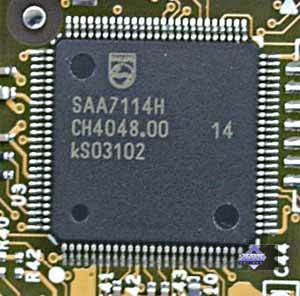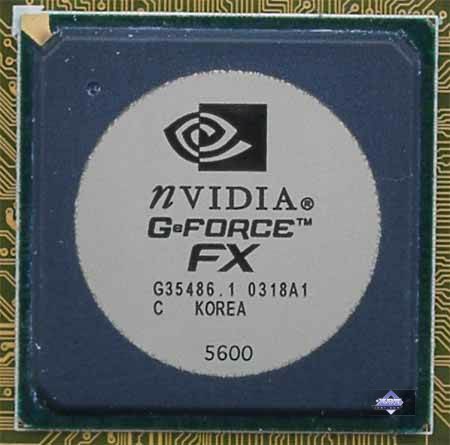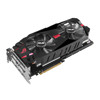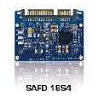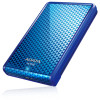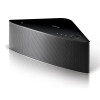
CONTENTS
- Video card's features
- Testbed configuration, test tools, 2D quality
- Comparison of the cards' performance
- Conclusion
How should we write about the GeForce4 Ti a year ago? - It's simple: the card had a decent speed gain (without anisotropy and AA), a dual-monitor support and other advantageous features. How should we write about the GeForce FX 5600 today? - It's not simple: the card has no speed gain without AA and anisotropy as compared to the Ti 4200, and it often works slower. An average user doesn't need the DX9 support yet. All other features were supported yet in the GF4Ti. The FX 5600 shows an advantage only with AA and/or anisotropy enabled. But most users do not know yet how to adjust 3D accelerator's settings.
Nevertheless, ATI and NVIDIA have left the speed race and are now focusing on refinement of graphics quality by launching GPUs able to process AA and anisotropy faster. That is why a user should know the rudiments of 3D graphics if he wants to get benefit from latest solutions.
One need to know that anisotropic filtering is almost the most important function for visual quality in 3D scenes. This function can be enabled in all drivers' settings. See our previous reviews for details.
Theoretical materials and reviews of video cards which concern functional
properties of the GPU
- Analysis of the architecture of NVIDIA NV30 (GeForce FX)
- NVIDIA GeForce FX 5800 Ultra (NV30) - single-page review
- NVIDIA GeForce FX 5800 Ultra (NV30) - multi-page review
- NVIDIA GeForce FX 5600 Ultra (NV31) and GeForce FX 5200 Ultra (NV34) - single-page review
- NVIDIA GeForce FX 5600 Ultra (NV31) and GeForce FX 5200 Ultra (NV34) - multi-page review
- ASUS V9900 Ultra on NVIDIA GeForce FX 5800 Ultra - AA and anisotropy quality
- Gainward FX Powerpack Ultra/1000 Golden Sample and Gainward FX Powerpack Pro/660 TV/DVI on NVIDIA GeForce FX 5800 Ultra and 5200 - scaling (performance vs. CPU clock speed) of GeForce FX 5800 Ultra, performance of GeForce FX 5200
- Leadtek WinFast A300 Ultra MyVIVO on NVIDIA GeForce FX 5800 Ultra - performance of GeForce FX 5800 Ultra vs. CPU clock speed in heavy modes with AA and anisotropy enabled
- MSI FX5800 Ultra-TD8X on NVIDIA GeForce FX 5800 Ultra
- Albatron, Chaintech, Gainward, InnoVision, Leadtek, Palit and Prolink video cards on NVIDIA GeForce FX 5200
- Albatron, Leadtek and MSI video cards on the NVIDIA GeForce FX 5200 Ultra
The basic review of the GeForce FX 5800 has some details on the anisotropy. More information can be found in the 3Digest section dedicated to this function.
Anti-aliasing (AA) is also an important function that improves quality of graphics perception and does away with stair-step appearance. The reviews listed above also have some information on AA.
Last time we found out that the FX 5600 came to replace the low-end GeForce4 Ti. The cards based on this processor can have their cost reduced much thanks to a cheaper GPU (cheaper production) and TSOP memory; besides, the PCB itself is not expensive. That is why the current overpricing that appeases the appetite of traders and vendors won't last long.
Owners of the GeForce4 Ti have no reason to replace their cards with the FX 5600, but if you want a card within $150-190 and want to get maximum of it, you can go with the FX.
Besides, it's not an ordinary card among those built on this processor. First of all, it has its chip and memory clock increased (350/300 (600) MHz against 325/275 (550)), and secondly, it has 256 MB video memory instead of 128 MB (though even 128 MB memory is not used in full measure by game developers). Thirdly, it sports the VIVO support.
This unique product is made by Prolink, - a Taiwanese company whose PixelView trade mark is well known on the market. Prolink has been dealing with multimedia solutions for a long time already, and the market offers offers a great deal of its TV tuners. 4 years ago Prolink successfully stepped into the videocard market using only NVIDIA's processors. This prosperous company is NVIDIA's official partner. I must say that some Prolink's cards (like for example Gainward's ones) have quite peculiar features.
Today we are going to test one of such cards. The Golden Limited title lets this card run at higher than rated clock speeds, like the Golden Sample of Gainward. But while Gainward's cards come clocked at their rated values, and they can be lifted by 10-15% with special software from Gainward, the Golden Limited line has the higher frequencies from the very beginning.
Card
| Prolink PixelView GeForce FX 5600 256MB Golden Limited | 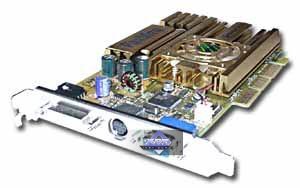 |
|
| AGP x8/x4/x2 interface, 256 MB DDR SDRAM in 8 chips on the front and back PCB sides. | |
| Prolink PixelView GeForce FX 5600 256MB Golden Limited | |
| Samsung memory chips of 3.3ns access time; it corresponds to 300 (600) MHz. Memory is clocked at the same frequency, GPU runs at 350(!) MHz (25 MHz over the rated value). 128bit memory interface. | 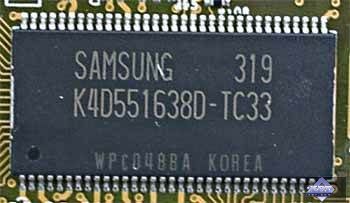 |
| Comparison with the reference design, front view | |
| Prolink PixelView GeForce FX 5600 256MB Golden Limited | Reference card NVIDIA GeForce FX 5600 |
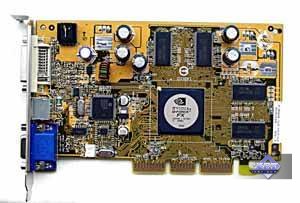 |
 |
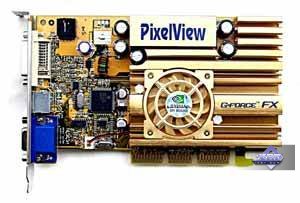 |
|
| Comparison with the reference design, back view | |
| Prolink PixelView GeForce FX 5600 256MB Golden Limited | Reference card NVIDIA GeForce FX 5600 |
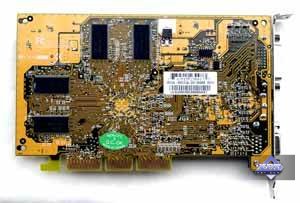 |
 |
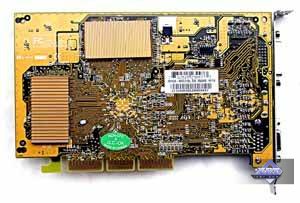 |
|
| Prolink PixelView GeForce FX 5600 256MB Golden Limited | |
| User Guide, CDs with drivers and utilities, WinDVD, several obsolete games, s/w for VIVO, adapters and extenders for TV-out (for VIVO as well), DVI-to-d-Sub adapter. | 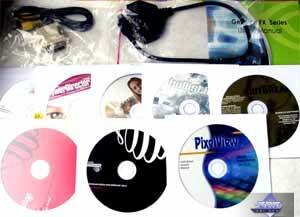 |
|
The card ships in the retail package. |
| Prolink PixelView GeForce FX 5600 256MB Golden Limited | |
| The card comes in a big colorful box with all necessary information written on top; even the memory type and clock are indicated. | 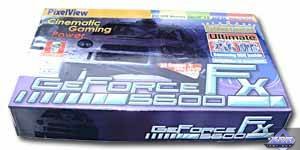 |
Testbeds and driversTestbed:
VSync off, S3TC off in applications. Test resultsBefore we start examining 2D quality, I should say there are no complete techniques for objective 2D quality estimation because:
With the ViewSonic P817 monitor and BNC Bargo cable the card showed excellent
quality at the following resolutions and clock speeds: |
| Prolink PixelView GeForce FX 5600 256MB Golden Limited | 1600x1200x85Hz, 1280x1024x120Hz, 1024x768x160Hz (nothing wrong with the quality!) |
Test results: comparison of the cards' performanceConventional signs: ANISO 8xB - Anisotropic 8x Balanced (this mode is currently called Performance), ANISO 8xQ - Anisotropic 8x Quality. Test applications:
Quake3 Arena, Quaver
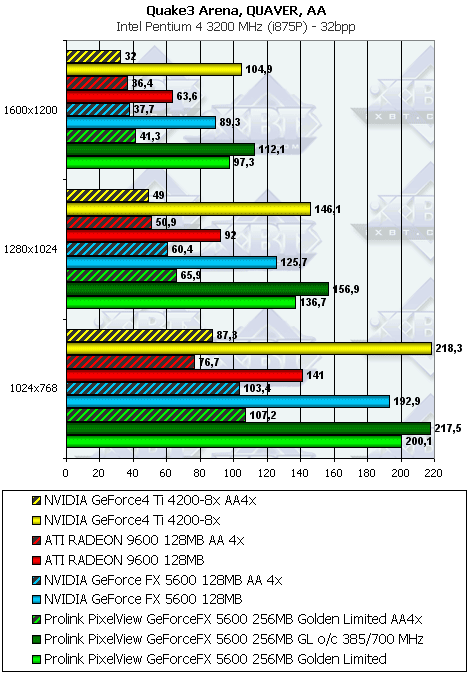 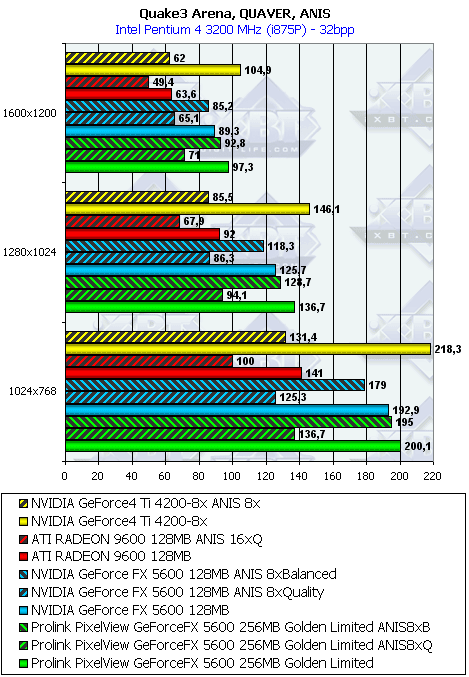 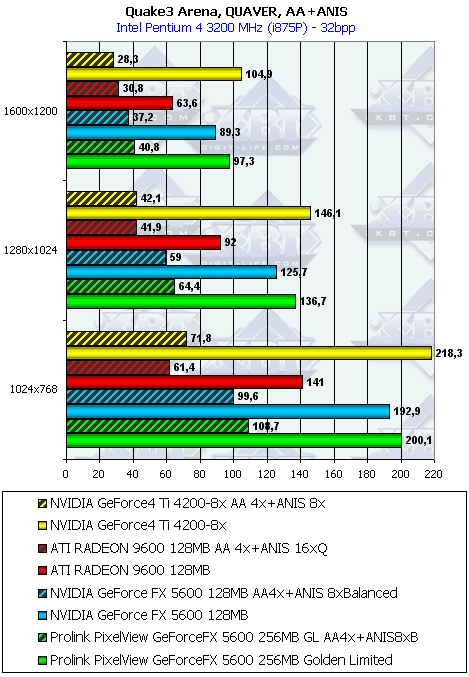 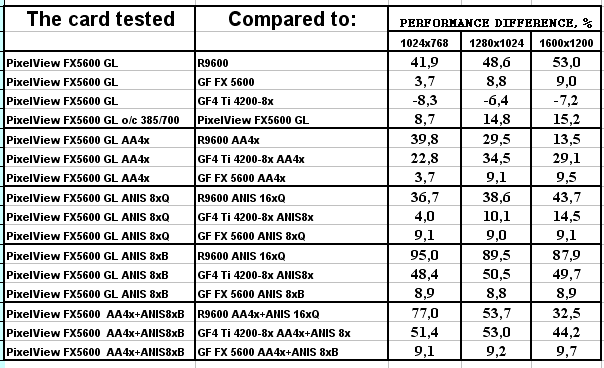 Serious Sam: The Second Encounter, Grand Cathedral
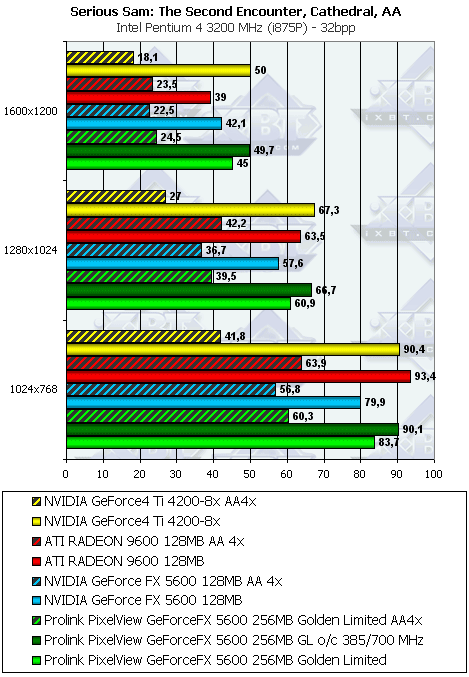 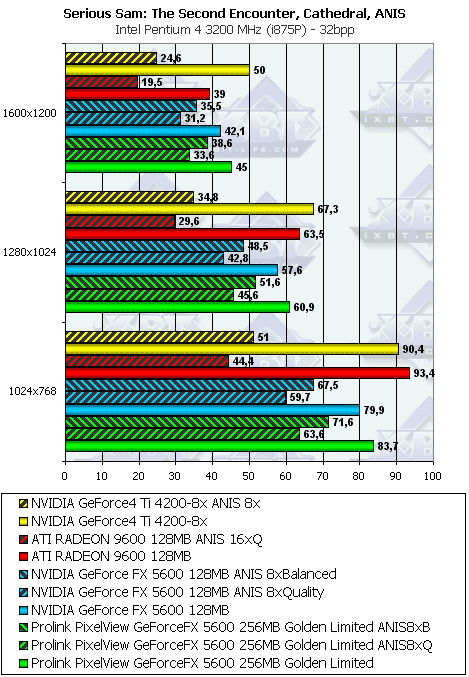 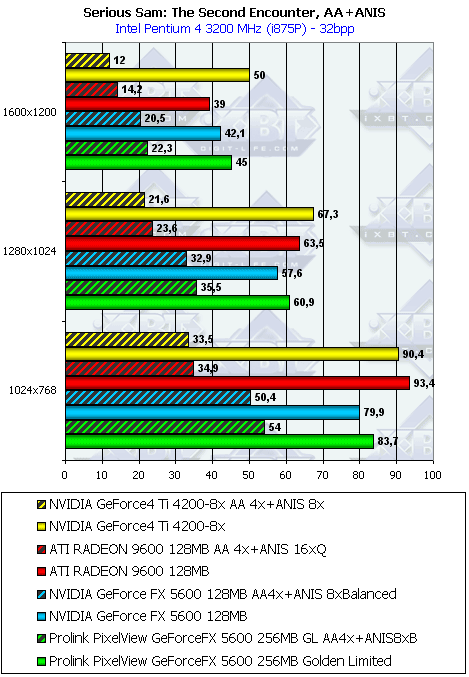 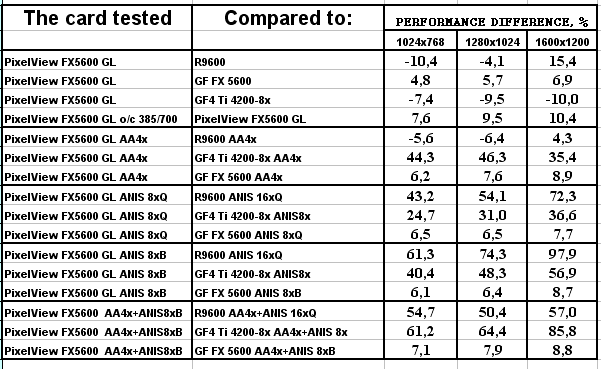 Return to Castle Wolfenstein (Multiplayer), Checkpoint
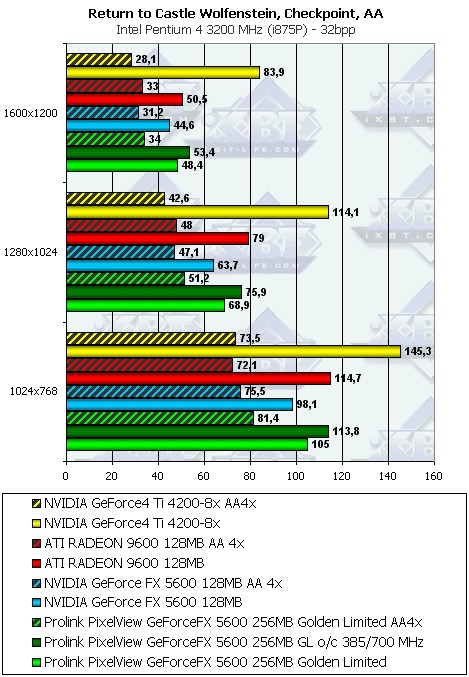 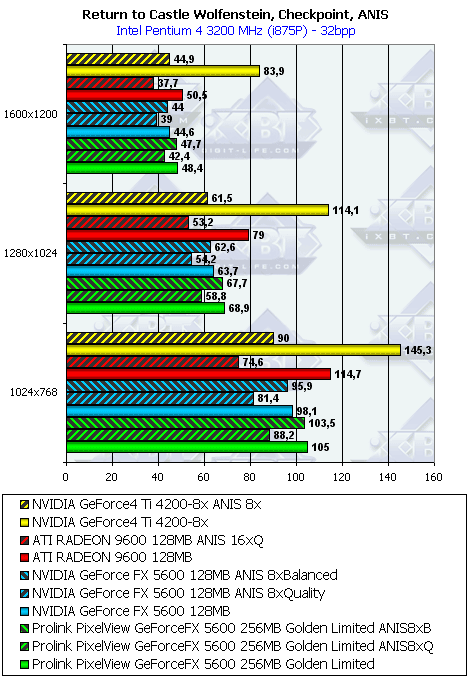 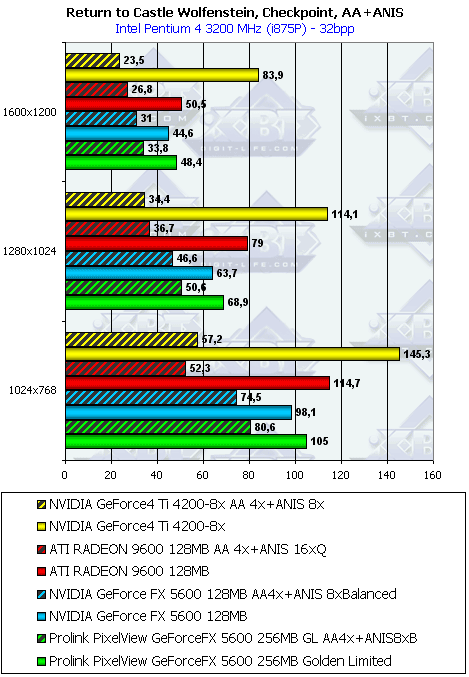 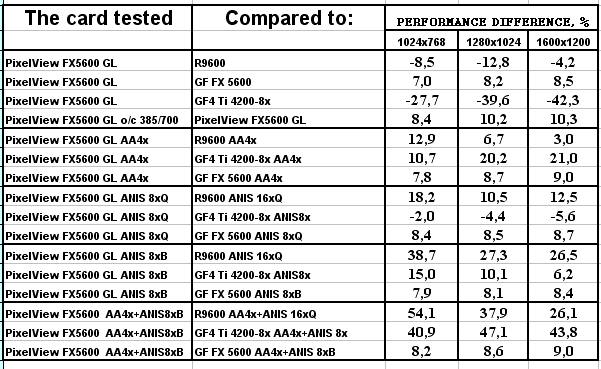 Code Creatures
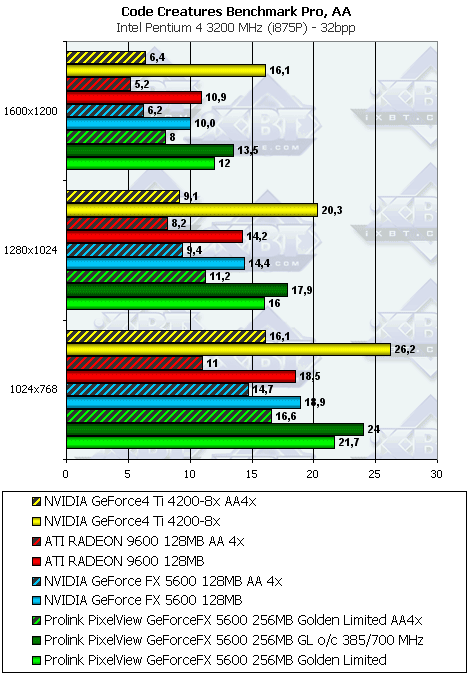  Unreal Tournament 2003 DEMO
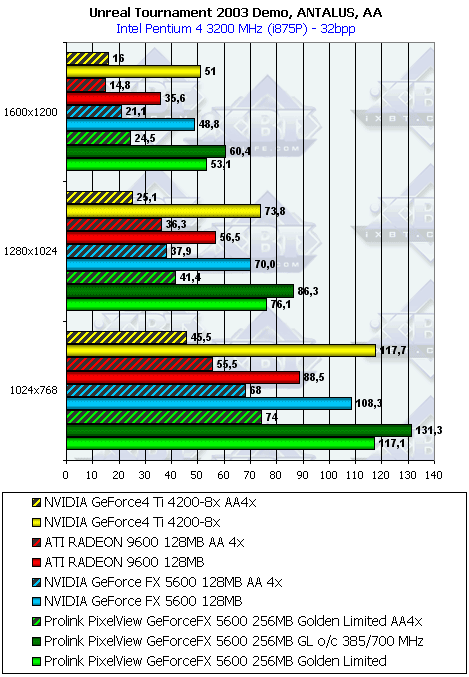 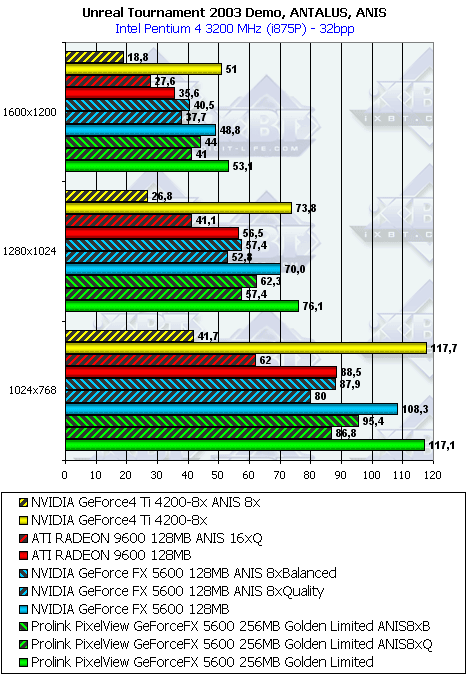 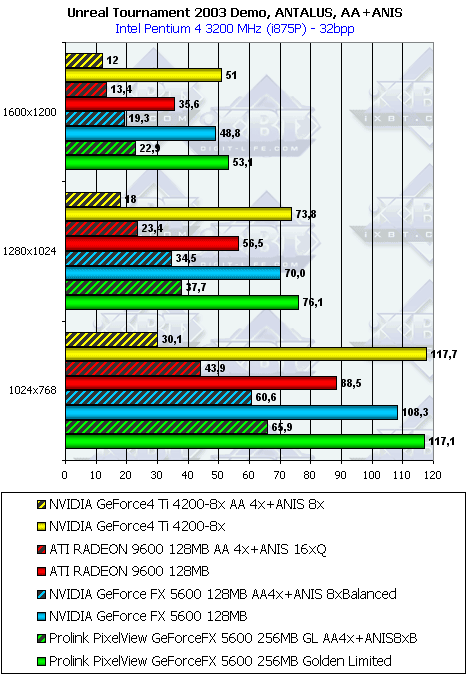 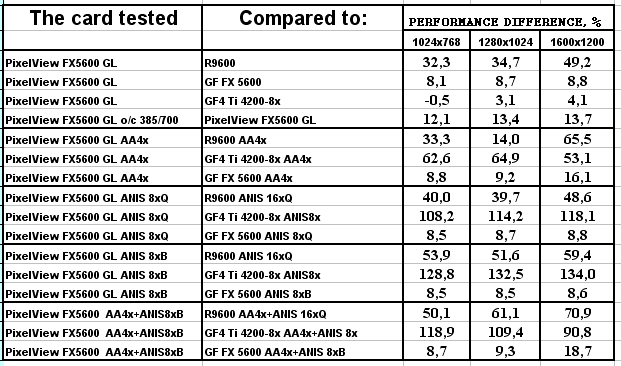 AquaMark
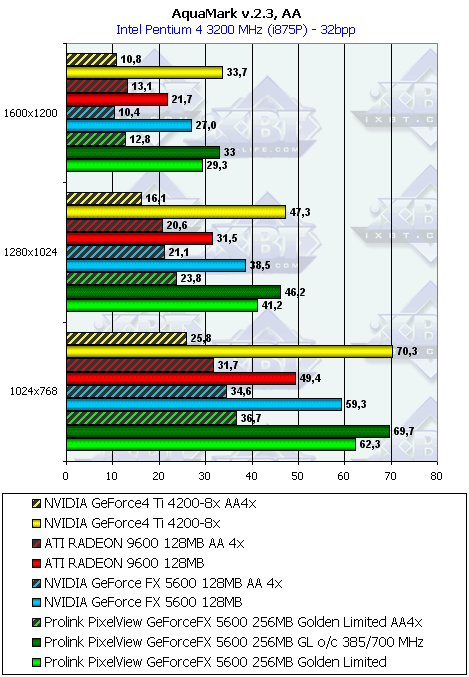 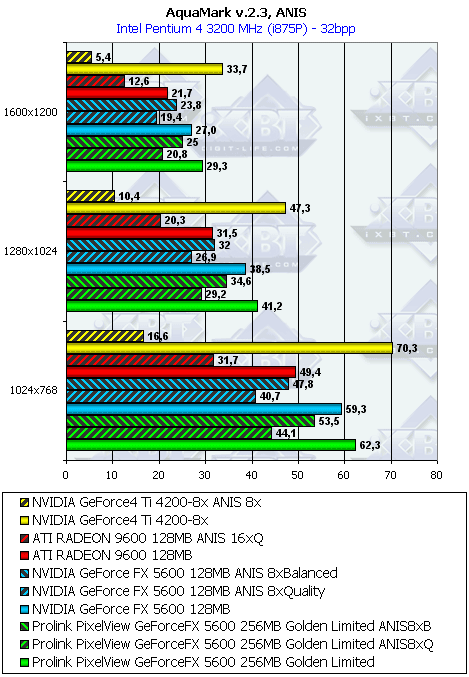 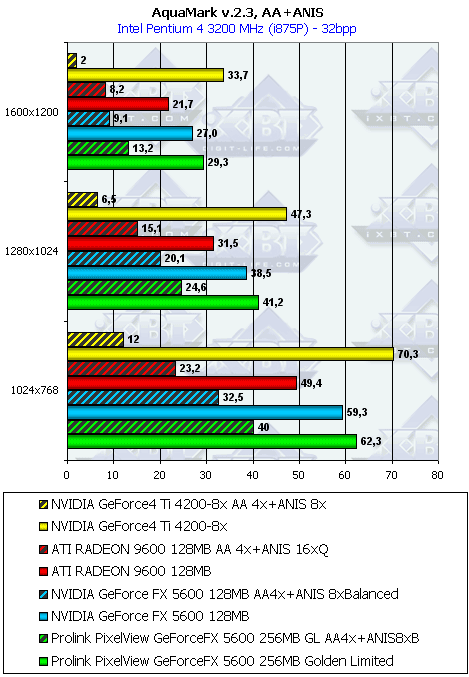 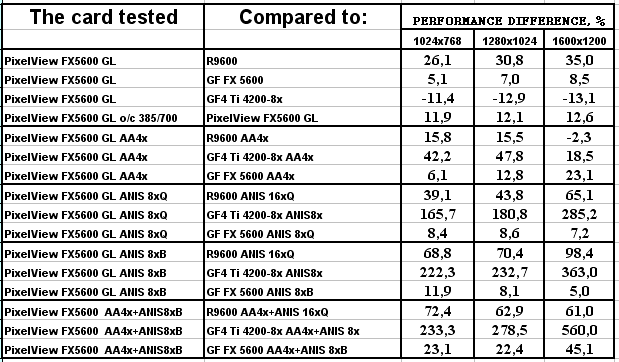 RightMark 3D
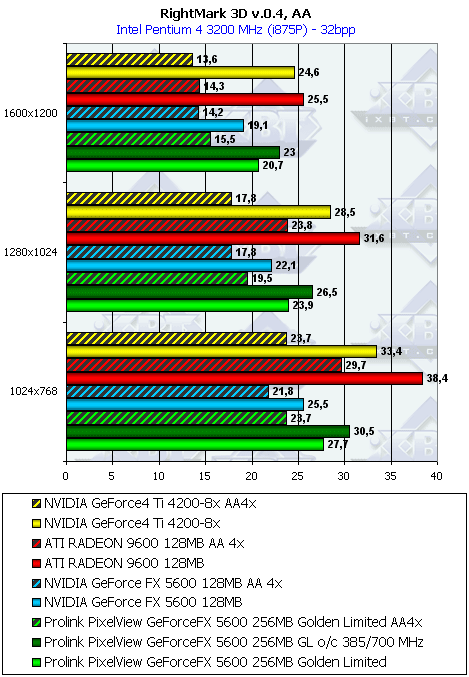 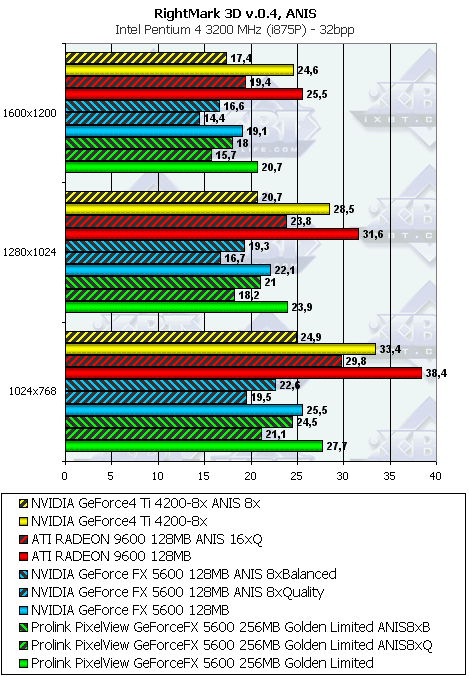 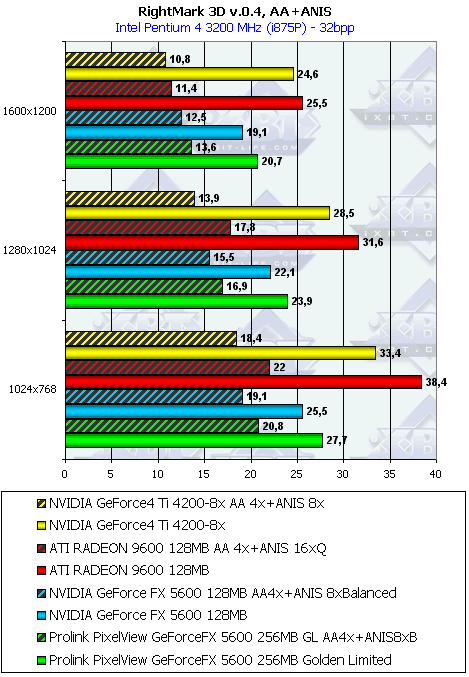 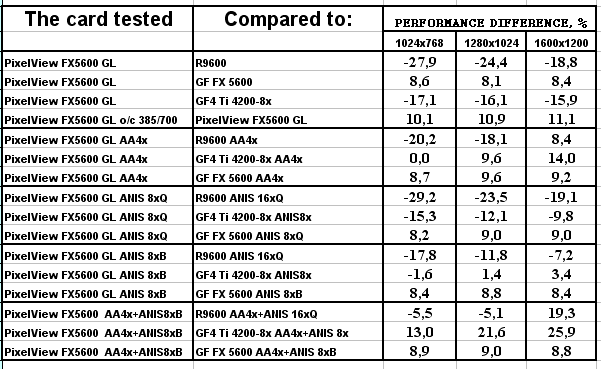 |
We can see again that when the AA and anisotropy are enabled the FX 5600 based card is unmatched among other models of this price range. Sure, the RADEON 9500 PRO can perform even better, but such cards are not produced anymore.
The diagrams do not compare 128MB and 256MB cards based on the FX5600 and running at the same clock speed, but I assure you that there is no difference at all whatever the test.
Conclusion
The Prolink PixelView GeForce FX 5600 256MB Golden Limited can give you:
- a higher speed in AA and/or anisotropy than its competitors (RADEON 9600 or GF4Ti 4200), and a higher performance than other FX5600 based solutions thanks to higher clock speeds;
- potentially a more technological solution with the DX9 support (such games are right around the corner already);
- VIVO support.
The Prolink PixelView GeForce FX 5600 256MB Golden Limited is actually the fastest card on the FX 5600 GPU for today!
In our 3Digest you can find full comparison characteristics for video cards of this and other classes.
In conclusion let me remind you that the FX 5600 series is a good choice
for users who want a card of the GF4 Ti 4200 level but with more efficient
AA and/or anisotropy modes, as well as the normal DX9 support. This Prolink
card is the right one! Besides, the prices keep on falling down (in the
USA the FX5600 128MB is already available at $140 (for the middle of June),
and the 256MB cards at $170; in Moscow they are nearing these pricetags).
Write a comment below. No registration needed!


